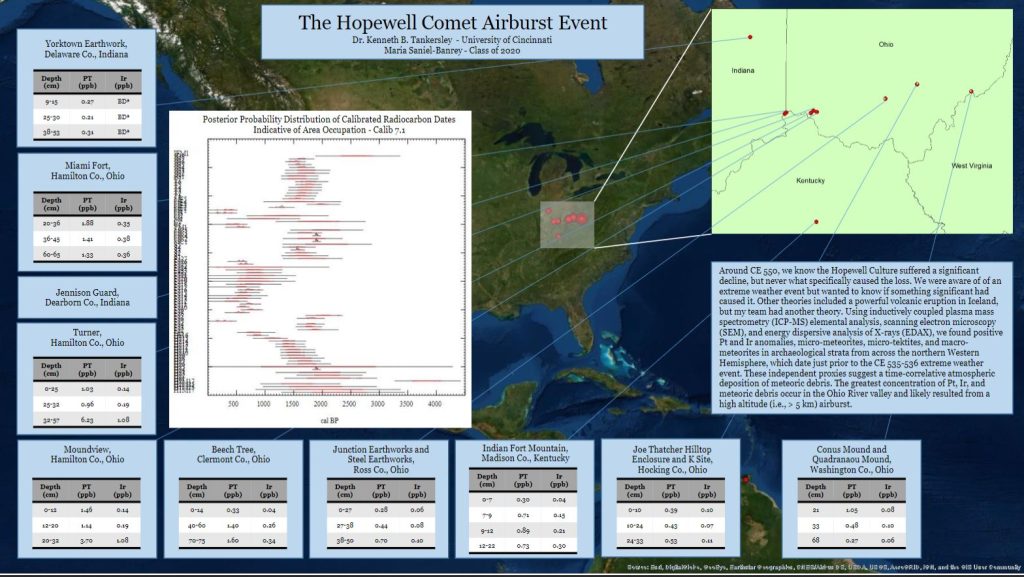
An American cosmic airburst in late Roman times has been revealed by Tankersly and Saniel-Banrey of University of Cincinnati in a new research paper.
Below you will find some interesting parts of the article:
Abstract
Meteorites, silicious vesicular melt glass, Fe and Si-rich magnetic spherules, positive Ir and Pt anomalies, and burned charcoal-rich Hopewell habitation surfaces demonstrate that a cosmic airburst event occurred over the Ohio River valley during the late Holocene.
A comet-shaped earthwork was constructed near the airburst epicenter. Twenty-nine radiocarbon ages demonstrate that the event occurred between 252 and 383 CE, a time when 69 near-Earth comets were documented.
While Hopewell people survived the catastrophic event, it likely contributed to their cultural decline. The Hopewell comet airburst expands our understanding of the frequency and impact of cataclysmic cosmic events on complex human societies.
Cosmic airbursts through history
Direct positive evidence of catastrophic cosmic airburst and impact events have been found in the Western Hemisphere at the Cretaceous and Tertiary (KT) boundary ~65 million years ago and at the Younger Dryas (YD) boundary ~12,800 years ago. Both of these events are associated with global mass extinctions and they occurred before humans culturally evolved into complex, sedentary, agricultural-based societies.
The recent discovery of two Holocene cosmic impact events in Argentina (~6,000 B.P. and ~3,000 B.P.), and one in Jordan (~3,700 B.P.), suggests that these natural catastrophes are far more common than previously suspected. Between 1,800 and 1,431 years ago (220 and 589 CE), Chinese astronomers documented 69 comets, including Haley’s, which came within 0.09 au of earth in 374 CE (1646 B.P.). At this time, human communities and the resources they needed for survival were at a heightened risk of being destroyed by a comet airburst event.
Comets are dirty fractured snowballs composed of cosmic dust, frozen gases, and meteoroids. In some cases, comets such as SL9 break apart and impact planets. If a comet fragment fell into the high-pressure air of earth’s thermosphere, an explosion, known as an airburst, would release a devastating high-energy shockwave over a large area resulting in burned agricultural fields, buildings, and forests as evidenced by the Tunguska event of 1908.
Archaeological evidence of ancient cosmic impact events, such as meteorites, tektites, and vesicular melt glass, has been recovered from archaeological sites of various ages in Europe, the Near East, and China.
In the western Hemisphere, Hopewell archaeological sites in the Ohio River valley contain an anomalously high concentration and diversity of meteorites when compared to all other cultural periods.
They include iron meteorites (e.g., ataxites, hexahedrites, 58octahedrites), stony iron meteorites (e.g., mesosiderites, pallasites), and stony meteorites (e.g., olivine hypersthene chondrites).
The spatial distribution, contexts, and diverse composition of Hopewell meteorites has been explained as acquisition through long-distance exchange systems and trade networks.
It is possible, however, that many of the Hopewell meteorites resulted from a single cosmic airburst event. Comets contain a variety of meteoroids with different elemental and mineralogical composition.
In order to address this possibility, the scientists examined the contextual and temporal evidence of comet airburst-related proxies at eleven Hopewell sites in the Ohio River valley. They used radiocarbon and typological dating to determine the timing of the event and suggest that it may have contributed to the social decline of the Hopewell.
Hopewell: Archeology
Genetic analyses demonstrate that modern Native Americans are the direct descendants of the Hopewell. The archaeological hallmarks of the Hopewell include monumental landscape architecture—the largest geometric earthen enclosures in the world, intricate water management systems, massive burial mounds, and extensive ceremonial centers.
Distinctive symbols, artwork, and exotic goods, which have been traced from unprecedented continental distances of more than 2,400 km indicate that the Hopewell had a widespread social network between ~100 BCE and 400 CE, which spanned the Atlantic Ocean to the Rocky Mountains and from Canada to the Gulf of Mexico.
The spatial and temporal distribution of Hopewell archaeological sites are associated with a stable and sedentary society with a political hierarchy. The greatest concentration of Hopewell archaeological sites occurs in the Ohio River valley with the largest ceremonial centers (hundreds of hectares) located along the tributaries of the Scioto and the Little and Great Miami rivers.
The earliest investigations of Hopewell archaeological sites began in the 18th century and accelerated during the late 19th and 20th century, resulting in detailed site maps, chronometric 85ages, and artifact provenances. While past investigations have focused on Hopewell economies, mortuary practices, sociopolitical interaction, social stratification, and symbolism, the reason for the rapid cultural decline of the Hopewell ~1,600 B.P. remains unresolved.
Theoretically, a comet airburst event is a possible explanation for the cultural downturn given that the period of near-Earth comets occurred immediately prior to the terminal age of Hopewell archaeological sites.
Hopewell mysterious decline
The Hopewell comet airburst event adds to our growing body of knowledge of catastrophic cosmic events, which led to cultural downturns in ancient complex, sedentary, and agricultural based societies.
Multiple comet airburst event proxies have been found on eleven Hopewell archaeological sites in the Ohio River valley, which have typological and calibrated radiocarbon age ranges of 1699-1567 B.P. (252-383 CE). This time period coincides with historically documented near-Earth comets and occurs prior to the cultural downturn of the Hopewell.
The discovery of meteorites, silicious vesicular melt glass, Fe and Si-rich magnetic spherules, vitrified clay, and thermally decomposed limestone on burned, charcoal-rich Hopewell habitation surfaces suggests that surface temperatures reached higher than 1,700°C, which would have burned wooden structures and altered the composition of C3 vegetation.
The cultural impact and geographic extent of cosmic airbust events can only be evaluated and interpreted through interdisciplinary investigations that include chronostratigraphy, petrography, and geochemical analyses.
These methods, if carried out rigorously, will provide a greater understanding of ancient catastrophic cosmic airburst events, their impact on complex human societies, and their frequency not only in the Western Hemisphere, but elsewhere in the world. [Science Paper]
Now subscribe to this blog to get more amazing news curated just for you right in your inbox on a daily basis (here an example of our new newsletter).
You can also follow us on Facebook and/ or Twitter. And, by the way you can also make a donation through Paypal. Thank you!
You should really subscribe to QFiles. You will get very interesting information about strange events around the world.













its AD Lets Go Brandon to the BCE and CE garbage shall we brittle pole and snowflakes?
https://humansarefree.com/2021/10/biden-administration-details-plan-to-quickly-vaccinate-28-million-children-age-5-11-even-though-the-jab-doesnt-prevent-transmission.html
28,000,000 children 5-11 due to be sterilized or vax suicide shot.
DO NOT BEND A KNEE TO SATANISTS!
https://www.thegatewaypundit.com/2021/10/will-put-bullet-heads-americans-haitian-gang-leader-threatens-kill-kidnapped-american-missionaries/
400 Bozo Gang of Hait threatens to kill Christian Missionaries:
They want 17 million dollars in ransom.
This won’t end well.
Meanwhile, 12,000 Haitian were let inside our borders, and many probably hate Americans, since Hitlery and her pal Silsby were swiping children (and caught in the act).
Also, none of the promises to Hati were accomplished. It was a huge scam. Many protested and our news media never showed the story. It was a huge scam and grift.
A good reason to never let satanists run our country. They have no conscience. All they do is create misery wherever they go.
https://humansarefree.com/2021/10/americas-frontline-doctors-murdered-infants-at-the-heart-of-vaccine-research.html
Nazi frankenscientists:
Well, read it. That’s why real Christians are NOT taking the vax suicide shots. Blood of innocents are used to create these fake vax shots. Fetal cell lines. Babies killed alive!
Do you get it?
One of the objectives is to steal your soul. Make you unclean for Heaven, and more suitable for h3ll.
“Strange Sounds”, ever hear of a MAP to go along with your article ??
I see a map on first graphic? Ohio.
Yes Alex Jones is our mutual friends. He is so ow-some indeed.
Thanks 50cal we are always on same track . .
?
I wonder if their culture practiced child or human sacrifices?
We already know from history, that ancient civilizations which practice abominations, have been destroyed.
If we had even a small scale airburst, then I suspect the effect would be of an EMP.
In theory, a false flag could be accomplished by using a satellite EMP, and blamed on a comet airburst, or blamed on a rogue country to initiate WWIII?
I know, sounds conspiracy theorist, but never rule out the depths of evil lengths people will go, which we see unfolding today.
https://humansarefree.com/2021/10/archons-gnostics-alien-intrusion.html
Gnostics, and Archons:
Sounds like demons are what Gnostics called archons, perhaps so are ET’s. Still a mystery. Since they (archons)use deception, they could be demons or interdimensionals?
That’s my take on this one. I will obey Christ, and stick with the Bible. I fail at times, but I repent, and try to correct myself.
https://www.infowars.com/posts/viral-video-woman-predicted-covid-pandemic-in-2019-warned-of-global-tyranny-vax-mandates/
Claudia predicted pandemic. So did Alex Jones in 2010. Proof.
https://www.thegatewaypundit.com/2021/10/wow-750-ge-federal-contract-workers-walk-protest-vaccine-mandates-ohio-must-see-video/
Exclusive:
Not reported by lamestream buttclown media.
750 GE employees walk out over vax suicide shot mandates.